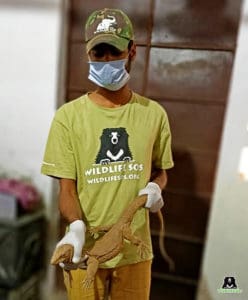With myths and misconceptions surrounding it, the Indian Monitor lizard often becomes the target of scared locals who see it as a threat
Last week, a Chandan Goira (Indian Monitor lizard) entered a house in Sesaipura village of Madhya Pradesh. Panicked villagers contacted the rescue team which took away the reptile . However, the time taken by the rescue team to arrive was enough for the panicked villagers, who were trying to kill it, to have injured the lizard. This is an everyday story — monitor lizards wandering in human settlements near forest areas.
The Indian Monitor lizard, part of the genus Varanus, is often killed by villagers due to the myths that surround this creature. Unfortunately, not a lot of research has been done around the animal, amplifying the fears people harbour about the animal.

Four species of Varanus lizards of various shapes and sizes are found in India: the Bengal monitor lizard Varanus bengalensis, desert monitor V. griseus, yellow monitor V. flavescens and water monitor V. salvator. Bengal Monitors (which can easily climb trees in search of birds’ eggs and are acclaimed for their strong grip) can grow upto a length of around 1.75 metre. The water monitor is one of the largest reptiles in the world, it can reach upto length of two metres.
Varanus lizards are known by various names like Chandan goira, Goyli, Goh, vish khopda, Ghrpada, Patlagho, badi chipkali, udumbo, uda and so on. Myths prevail, like “If it bites a person, that person dies right away without even asking for water.” “It spits out venom” are some of the reasons this animal is disdained by people.
“A half fit Chandan goira entered my aunt’s home and bit her, while she was working in the kitchen. She died right away,” says a 30-year-old Kusum. Such tales about these creatures are very common. Just the sight of the animal is enough to scare people off.
Darshan Soni, a reptile rescuer, says, “People tend to kill it because they think that it is venomous, but in fact this beautiful creature is harmless, they never attack unprovoked. Even if it bites, nothing happens but doctors suggest administration of a tetanus shot as this lizard may have bacteria in its mouth.”
All species of these lizards are listed under Schedule I of India’s Wildlife Protection Act, which makes capturing and poaching illegal. Wildlife scientists face big hurdles when it comes to research due to the stigma and it is one of the reasons why this animal is often ignored.
Scientists say that there is not much information available on the behaviour of varanids and its relation with ecology. Abhijit Das, scientist at the Wildlife Institute of India (WII) says, “We don’t have information on ecological or population-level data on India’s varanids that reflect current land use changes”. A team he is leading is studying varanids.

The reason mostly cited for the lack of information, is “obsession with mammals”, due to which these species are ignored.
Indian monitor lizards are skillful climbers and adept swimmers — with their unshakeable grip, they can climb walls and even steep mountains and trees without any support. If legends about these lizards are to be believed, they were part of every army’s toolkit. It is believed that Marathas used them to climb walls and capture impregnable forts, in fact a whole clan was named Ghorepade, after the name of these lizards. They would tie a stout rope around the waist of these lizards and send it clambering up the fort wall, then use that rope to scale the towering walls.
In May, three accused – Prabhu (21), Suri (22) and Ramesh (25) were held in Tamil Nadu for killing a monitor lizard and consuming its meat. They also uploaded a video clip of the capture of the monitor lizards that went viral on TikTok. Unfortunately, many of these lizards are poached for meat, medicine and myths related to good luck.
In 2017, World Animal Protection mentioned online retailers trading penises of these lizards know as “Hatha Jodi” as some tantric plant roots, “Monitor Lizard Hemipenis is being passed off as tantric plant roots also known as Hatha Jodi to unwitting customers via major online retailers including Amazon, Ebay, Alibaba, Snapdeal and Etsy among others.”
These lizards are also poached for leather and for making percussion instruments. Their meat and almost every body part is used for medicinal purposes.

Due to the loss of habitat and the constant threat from humans it’s population is declining globally. The lack of concise data about the population and its distribution is also a major hurdle in conservational efforts. And without precise data, proper steps towards educating people and conserving the species, their survival could soon be threatened.
(Cover: Indian monitor lizard on a coconut tree // Credit – Rayees Rahman, Facebook.)





